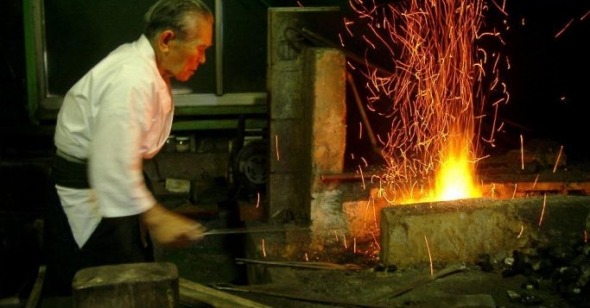Names and Faces
by Michael Joshua Rowin
Yasukuni
dir. Li Ying, Japan/China, The Film Library
Among the former Axis powers Japan continues to have the greatest difficulty confronting its World War II legacy. Whereas Germany and Italy have largely looked back on their fascist eras with self-criticism and remorse, Japan and its leaders still refuse to acknowledge the imperialistic misadventures and war crimes committed under Prime Minister Tojo, especially those concerning the invasion of China and the infamous Rape of Nanking. Even Japanese school textbooks redact mentions of these atrocities—in the Land of the Rising Sun silence and revisionism are official policy.
In his new film Yasukuni Chinese director Li Ying locates the physical and spiritual embodiment of Japan’s relationship to its own history at the Yasukuni War Shrine in Tokyo, where the souls of the 2.46 million soldiers who died fighting for their country are said to dwell. The Shinto monument has garnered controversy since the end of World War II for enshrining convicted war criminals and listing Taiwanese and Korean men conscripted into service against their will as among the honored dead; furthermore its auxiliary museum frames Japan’s role in WWII as defensively justified, serving as a reminder of the country’s resilient militarism and jingoism. National pride dies hard: last spring current prime minister Taro Aso came under fire from Japan’s left and the international community for praying at the shrine.
Yasukuni, which focuses on similar tensions surrounding former Prime Minister Junichiro Koizumi’s visit a few years ago, has already met with intense resistance in Japan from a right-wing contingent that initially prevented it from screening at theaters after sending a torrent of death threats. By courting danger and sparking dialogue Yasukuni might be labeled de facto essential viewing—the kind of film to be commended for its taboo-busting courage—even though the content itself is a mixed bag. This is because Yasakuni lives and dies by Ying’s penchant for vérité-style in-the-moment drama, which yields material both scintillating and dull.
Using only a few intertitles and interviews to put the Shrine’s notoriety into context, Ying constructs the majority of his film from long takes recorded on a video camera, the highlights coming from skirmishes that take place at Yasukuni: an American man brandishing a pro-Koizumi sign receiving encouragement for championing traditional values as well as flack for disrespectfully waving Old Glory as part of his show of support; a party led by the secretary general of the Jodo Shinshu Families Association demanding Shinto priests erase particular names from the Shrine; and the beating of a protester by hard right zealots as heads of state sing the national anthem at a WWII commemoration.
Such raw scenes perfectly attest to the emotions inspired by Yasukuni and all it represents—patriotic sacrifice, imperial conquest, stubborn disavowal—but much of Ying’s film could have been left on the cutting room floor. While footage of 90-year-old Naoji Kariya, the last living swordsmith to have forged blades on the Yasukuni grounds, making a beautiful engraved weapon is fascinating, his interview segment flounders when most of Ying’s questions about wartime memories are met with terse evasions. Naoji’s reticence to talk of the past speaks volumes, of course, but Ying lingers far too long on the tight-lipped older man, letting minutes go by with little to show for it. Perhaps Naoji was kept in the two-hour film out of respect for his work and its metaphorical importance—a ceremonial object in the Shinto religion, a single sword worshipped at Yasukuni possesses the spirits of all the warriors who died for Japan; swords were also given to WWII soldiers who then used them for beheadings. Yet that doesn’t excuse the long-windedness of Yasukuni as a whole, and the film’s indulgences are summed up by a climactic, nearly ten-minute montage of WWII newsreel footage that quickly becomes a tired exercise in mournful lyricism.
Ying’s intermittent poor choices are regretful because Yasukuni could have taken the time to instead delve into a host of questions it never raises. For instance, why is the denial of the truth a mainstream value in Japan? Does it stem from Japanese culture or its national character? Is it overcompensation for the defanging of the Japanese military beginning under U.S. occupation? Or does it come from something else? Yasukuni’s aesthetic immediacy stands out amidst the many contemporary static talking-head documentaries, but a little more analysis might have buttressed its frontline reportage and made it as politically incisive as it is emotionally charged.
